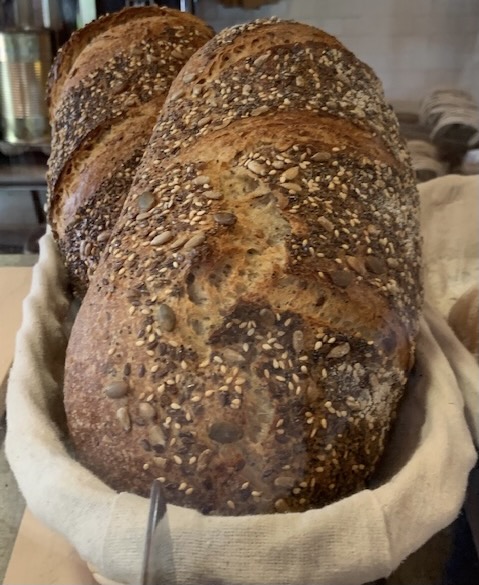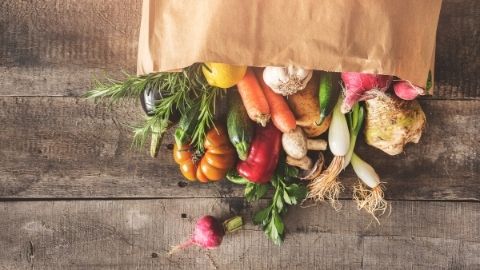Consumer Taste Beliefs Impact Organic Specialty Baked Good Pricing
Introduction
Taste is one of the most important food product attributes, including specialty bakery products (Drugova et al., 2020; Kuhar et al., 2020). Consumers do not always have accurate product taste information, such as that based on their actual past experiences with the product. Often, they rely on their perceptions and beliefs, which may be influenced by other product information, such as appearance or labels, both of which may bias consumer taste evaluation either positively or negatively. In turn, taste beliefs rather than actual taste may influence consumer demand and their willingness or purchase or pay for a product (Malone & Lusk, 2017; Neuhofer & Lusk, 2021).
In this fact sheet, we discuss how consumer taste beliefs related to organic specialty baked goods differ from their taste beliefs for conventional specialty baked goods, and whether this difference affects the amount consumers are willing to pay for organic-labeled specialty baked goods. In other words, we examine how an organic label on baked goods affects taste perceptions and willingness to pay (WTP). Further, we examine whether providing information about organic labeling standards changes consumer taste beliefs and impacts WTP for organic baked goods. Finally, we examine the impact of providing taste information to mimic scenarios where respondents know the actual taste, to examine if the provided taste information can compensate for negative taste beliefs. The analysis used three different specialty baked goods—bread loaf, croissant, and large cookie.
Data Overview
Data were collected through a nationwide consumer survey, which was conducted online in fall 2021. In total, we received 721 responses, of which 359 respondents were provided information about organic labeling standards (treatment group), and the remaining 362 respondents did not (control group). Table 1 reports summary socio-demographics for each group. No significant differences exist in average age, proportion of females, proportion of households with children, average education, and average income. This is important to ensure that results are not due to or biased by differences between the two groups. The only difference is the higher proportion of Caucasians in the control group.
Table 1.
Sample Demographics
|
Variable
|
Description |
Control (C) |
Treatment (T) |
|
Age |
2 = 18–24; 3 = 25–44; 4 = 45–64; 5 = 65 or more |
3.61 |
3.69 |
|
Female |
1 = female; 0 = male |
0.52 |
0.48 |
|
Children under 18 |
1 = present in the household; 0 = not present |
0.35 |
0.32 |
|
Education level |
1 = middle school; 2 = high school; 3 = some college; 4 = 2-year college; 5 = 4-year college; 6 = graduate school |
3.69 |
3.74 |
|
Employed |
1 = yes, full- or part-time; 0 = no |
0.66 |
0.65 |
|
Income level |
1 = less than $10,000, … 6 = $50,000–$59,999, … 12 = $150,000 or more |
5.98 |
5.99 |
|
Caucasian |
1 = yes; 0 = no |
0.81* |
0.74* |
|
N |
Number of respondents |
362 |
359 |
Notes. We compared the average values of both groups. The asterisk (*) denotes the averages are significantly different.
Product Taste Ratings
Respondents were asked to rate the taste of organic and conventional versions of bread loaf, croissant, and large cookie on a scale from 1 = very poor to 5 = very good. Products were not provided for respondents to taste (the survey was conducted online), and so the ratings are based on their previous experiences or beliefs. Table 2 shows average taste ratings for the examined products, difference in taste ratings for organic and conventional products, and the percentage of respondents who rated the organic product taste as better, calculated separately for control and treatment groups.
Table 2.
Taste Ratings for Organic and Conventional Baked Goods
|
Product |
Control (C) |
Treatment (T) |
|
Bread loaf |
||
|
Organic (O) |
3.64 |
3.55 |
|
Conventional (C) |
3.99 |
3.84 |
|
Diff. (O - C) |
-0.35* |
-0.29* |
|
Organic tastes better % |
18.8% |
17.8% |
|
Croissant |
||
|
Organic (O) |
3.66 |
3.56 |
|
Conventional (C) |
4.12 |
3.93 |
|
Diff. (O - C) |
-0.46* |
-0.36* |
|
Organic tastes better % |
15.2% |
17.0% |
|
Large cookie |
||
|
Organic (O) |
3.61 |
3.53 |
|
Conventional (C) |
4.20 |
4.03 |
|
Diff. (O - C) |
-0.59* |
-0.50* |
|
Organic tastes better % |
13.5% |
15.3% |
Note. The asterisk (*) means the difference in average ratings between organic and conventional products is statistically significant.

The results show that average taste ratings are lower for organic products than conventional for all examined products. This means that consumers view the taste of organic bakery products as inferior, and there is no change even when respondents receive information about organic labeling standards. This is likely due to consumer beliefs that organic products are healthy and the perception that healthy foods are not as tasty (Raghunathan et al., 2006). Considering the importance of taste for bakery products, especially pastry products, this may have negative impacts on consumer demand and WTP for these products. However, some consumers rated the organic bakery products as tastier, ranging from 13.5% of respondents for cookies (control group) to 18.8% for bread (control group).
Consumer Willingness to Pay (WTP)
An experiment was conducted on choice, where respondents were repeatedly asked to choose a product they would purchase in a bakery/store. They also had the option to choose none of the offered products. The products were described using taste information (poor taste, fair taste, good taste, or no taste information), organic and local label (present or absent), and price. Figure 1 shows a choice task example for croissants. We used respondents’ hypothetical choices to calculate their WTP for each taste level, organic label, and local label. Average WTP values are reported in Table 3.
Figure 1. Example Choice Task, Croissant

Table 3.
Willingness to Pay (WTP) Values
|
Bread loaf |
Croissant |
Large cookie |
||||
|
Control |
Treatment |
Control |
Treatment |
Control |
Treatment |
|
|
Organic alone |
$0.63* |
$0.89* |
$0.98* |
$0.66* |
$0.36* |
$0.26* |
|
Organic taste belief |
$3.33* |
$2.07* |
$2.03*,a |
$0.73*,a |
$2.17* |
$1.63* |
|
Organic total |
$3.96* |
$2.97* |
$3.01*,a |
$1.39*,a |
$2.53* |
$1.89* |
|
Conventional taste belief |
$3.65* |
$2.24* |
$2.29*,a |
$0.81*,a |
$2.53* |
$1.86* |
|
Organic minus conventional |
$0.31 |
$0.72 |
$0.73 |
$0.58 |
$0.00 |
$0.03 |
|
Local |
$0.61* |
$0.77* |
$0.38* |
$0.32* |
$0.26* |
$0.13 |
|
Poor taste |
-$7.91* |
-$8.46* |
-$5.87*,a |
-$4.79*,a |
-$3.28* |
-$3.56* |
|
Fair taste |
$1.68* |
$1.47* |
$0.77* |
$0.47* |
$0.59* |
$0.53* |
|
Good taste |
$5.89* |
$5.79* |
$3.64* |
$3.30* |
$3.28* |
$3.47* |
Notes. The asterisk (*) denotes the estimate is statistically significant. WTP is associated with taste beliefs for organic and conventional products was calculated using average taste beliefs.
The superscript a denotes that the differences in estimated WTP between the control and the treatment groups for a given bakery product are statistically significant.

Results in Table 3 show that total WTP for the organic product ranges between $1.39 for croissants (treatment group) and $3.96 for bread loaf (control group). However, most of the WTP value is linked to consumer taste beliefs. When taste beliefs are not considered, WTP for the organic product is between $0.26 for large cookies (treatment group) and $0.98 for croissants (control group). As mentioned earlier, consumers often feel that conventional bakery products taste better than organic. This is also reflected in their higher WTP for conventional products. The difference in total WTP for organic and conventional baked goods is positive but not statistically different from zero.
In summary, if taste beliefs for organic and conventional bakery products were the same (i.e., both products taste equally good in consumers’ minds), then consumers would be willing to pay extra for the organic version. However, when considering average taste ratings for organic and conventional baked goods in our sample, WTP for the organic product is practically zero. In other words, on average, organic labels impact taste perceptions negatively, and the taste beliefs in turn affect WTP for organics negatively. Still, taste ratings differ among respondents (some rate the taste of organic higher, as shown in Table 2). Also, in the analysis, we assumed that consumers do not consider their taste beliefs equally when choosing a product. For example, the organic label may be more important than taste to some consumers, and these consumers might be willing to compromise on the taste.
Comparing WTP values between control and treatment groups, we find that the values tend to be lower in the treatment group; they are not positive, as might be expected. However, the differences in WTP are statistically significant only for croissants. Overall, we find that educating consumers about organic labeling standards does not improve their taste perceptions of organic products nor their WTP for organic baked goods. Finally, results also show that consumers value good and fair taste but require a discount for poor taste. We also find that providing positive taste information such as fair or good taste can compensate for the impact of negative taste beliefs on WTP for organic baked goods. Overall, consumers are also willing to pay extra for the local label, which we used to denote freshness.
Conclusions
In this fact sheet, we compared taste beliefs related to conventional and organic specialty baked goods and their impact on consumer WTP for these products. We also investigated the impact of providing information about organic labeling standards and taste on WTP values.
On average, consumers feel that organic specialty baked goods taste worse than their conventional counterparts, which has a negative impact on their overall WTP for the organic products. However, if consumers rate organic and conventional products as equally tasty, then they are willing to pay extra for the organic products. In fact, we find that there is a small share of respondents who rate organic baked goods as tastier, so this segment of consumers is interested in and willing to pay more for the organic specialty baked goods. Marketing efforts should be targeted toward this segment and much less toward the education of consumers about organic labeling standards, which did not help to improve taste ratings nor WTP values. Providing favorable taste information (e.g., through sampling) could also help overcome the negative effect of organic taste beliefs.
References
- Drugova, T., Curtis, K. R., & Akhundjanov, S. B. (2020). Organic wheat products and consumer choice: A market segmentation analysis. British Food Journal, 122(7), 2341–2358. https://doi.org/10.1108/BFJ-08-2019-0626.
- Ellison, B., Duff, B. R., Wang, Z., & White, T. B. (2016). Putting the organic label in context: Examining the interactions between the organic label, product type, and retail outlet. Food Quality and Preference, 49,140–150. https://doi.org/10.1016/j.foodqual.2015.11.013.
- Kuhar, A., Korošec, M., Bolha, A., Pravst, I., & Hristov, H. (2020). Is a consumer perception of salt modification a sensory or a behavioural phenomenon? Insights from a bread study. Foods, 9(9), 1172. https://doi.org/10.3390/foods9091172.
- Malone, T., & Lusk, J. L. (2017). Taste trumps health and safety: Incorporating consumer perceptions into a discrete choice experiment for meat. Journal of Agricultural and Applied Economics, 49(1), 139–157. https://doi.org/10.1017/aae.2016.33.
- Nadricka, K., Millet, K., & Verlegh, P. W. (2020). When organic products are tasty: Taste inferences from an Organic = Healthy Association. Food Quality and Preference, 83, 103896. https://doi.org/10.1016/j.foodqual.2020.103896.
- Neuhofer, Z. T., & Lusk, J. L. (2021). Decomposing the value of food labels on chicken. Journal of Agricultural and Applied Economics, 53(2), 229–245. https://doi.org/10.1017/aae.2021.2.
-
Raghunathan, R., Naylor, R. W., & Hoyer, W. D. (2006). The unhealthy = tasty intuition and its effects on taste inferences, enjoyment, and choice of food products. Journal of Marketing, 70(4), 170–184. https://dx.doi.org/10.1509/jmkg.70.4.170.
Published February 2023
Utah State University Extension
Peer-Reviewed Fact Sheet
Authors
Tatiana Drugova, Post-Doctoral Fellow, Department of Applied Economics; Kynda R. Curtis, Professor and Extension Specialist, Department of Applied Economics
Related Research














